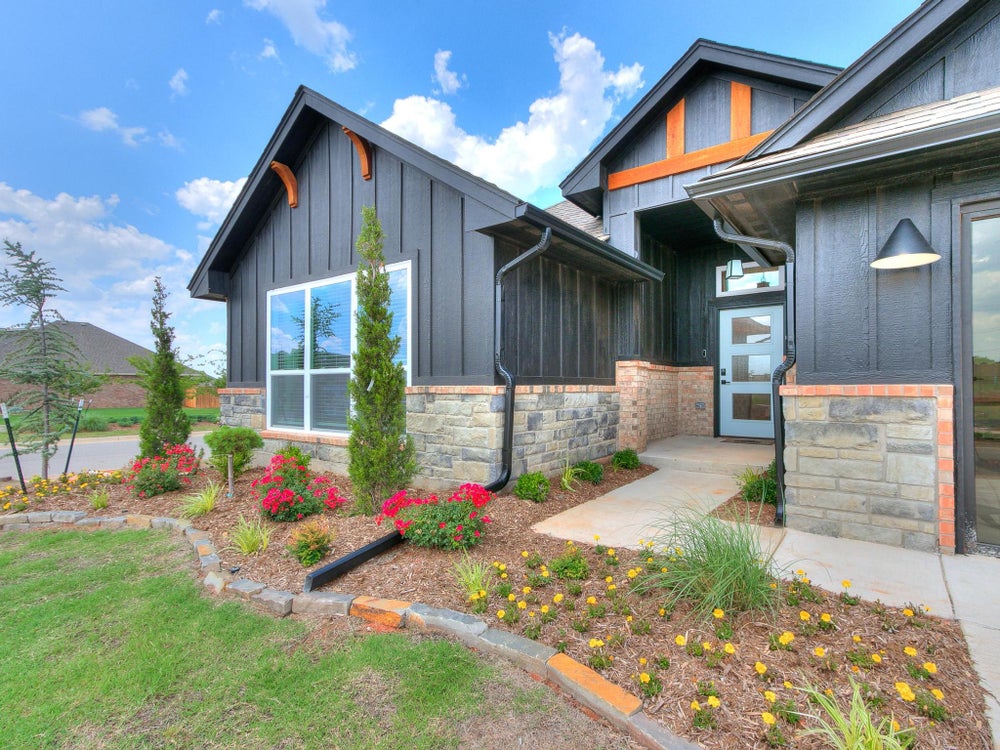Landscaping Ideas for Oklahoma Home Builders: Drought-Tolerant and Native Plant Options

Although it may be one of the last steps in building your new home, landscaping should be included from the very beginning of the construction process. Landscaping does more than improve the visual aesthetics and curb appeal of your home. Good landscaping can help:
Increase property value, security, and privacy
Protect your home from pests, erosion, and extreme weather
Reduce your environmental footprint and support the native environment
Provide safe and shady green spaces for outdoor living
Reduce upkeep as well as the time and costs necessary for maintenance
However, proper landscaping requires proper planning, including taking into consideration things like the climate where you live and your local ecosystems. In Oklahoma, weather is a big planning factor for homeowners and builders, so having a good understanding of what will work where can mean the difference between a beautiful, effortless landscape and a cumbersome one that struggles to thrive.
Landscaping Considerations Specific to Oklahoma
Oklahoma is a relatively large state that spans three USDA hardiness zones, which can help delineate what plants will thrive in what areas. It also experiences large swings in temperature and weather patterns and boasts a variety of ecosystems, from heavily wooded areas to wide open prairie. Some specific considerations when planning the landscape for your new home include:
Wind. For landscapes with little to break the wind, it’s important to think about planting trees and plants that are strong enough to withstand the straight line winds that come with Oklahoma storms.
Rain. Oklahoma frequently experiences sustained droughts and dry periods throughout the western and central parts of the state, while the east and south tend to be significantly wetter.
Temperature. Temperatures in Oklahoma can soar well over 100 during the summer and fall below freezing in the winter, and residents routinely see dramatic 24-hour temperature swings in one direction or the other. Landscapes should be designed to tolerate pleasant spring-like temperatures on one day and freezing rain the next.
Soil. Much of the soil in central Oklahoma is dry, acidic clay that does not retain moisture well.
Native Plants for Oklahoma Landscaping
To create a beautiful, sustainable, and easy-to-maintain landscape for your new home, it’s important to do more than just pick plants you think are pretty. You should consider the natural environment around your home, as well as the climate and weather patterns your new landscape will need to hold up to. Here are some native plant ideas that support most local ecosystems and thrive throughout all of Oklahoma’s seasons.
Lawn grass. The Oklahoma environment can support a variety of types of lawn grass, but the best type for your landscape will depend on a lot of factors, including soil conditions, shade, and availability of water. Most landscapes will benefit from varieties that can tolerate fluctuating water conditions, high temperatures in the summer, and low temperatures during the winter, or even a combination of varieties for year-round turf coverage. Common lawn grasses in Oklahoma include:
Bermuda
Buffalo
St. Augustine
Zoysia
Ryegrass (perennial and annual)
Kentucky bluegrass
Tall fescue
Plants and foliage. Some top picks might include milkweed, which plays a big role in supporting millions of monarch butterflies that migrate through the state every year. This colorful plant is native to Oklahoma and is a better choice than Easter lilies, which are a similar plant but don’t hold up to the heat and drought common here. Bellflower is also great for attracting hummingbirds and pollinators.
Other good flowering choices for Oklahoma landscapes are:
Crepe myrtles
Fragrant sand verbena
Wild yarrow
Prairie onion
Coneflowers
Oklahoma rose
Eastern blue star
Native and ornamental grasses like bluestem, Mexican feather grass, maidenhair grass, and pampas grass can also be an excellent choice for beautiful, hardy, and easy-to-maintain year-round foliage.
Groundcover. A variety called frogfruit is native to the southern US and is a perennial that will come back year after year to beautify the space with flashy white buds. It’s tolerant of both dry and wet seasons, making it ideal for the wide-ranging Oklahoma climate.
Other good options for native or drought-tolerant groundcover are:
Creeping phlox
Wild strawberry
Homestead verbena
Trees. Those looking for trees to spruce up a new construction space would do well to try any of a variety of redbuds, which happen to the state tree of Oklahoma. As its name suggests, homeowners can enjoy rich, vibrant reds in the spring when the tree is in bloom, and the following heart-shaped leaves don’t require much maintenance in order to survive everything the local climate can throw at them, from intense winds to blazing sun.
Other good tree selections include:
Roughleaf dogwood
River birch
Seaside alder
Red maple
Sugar maple
Willow oak
Despite their popularity, you should avoid Bradford pears because they easily outcompete native Oklahoma trees and plants, and their seeds are easily transported by animals, so they can spread far and wide quickly. Once established, a Bradford pear is not hardy enough to withstand Oklahoma’s climate, so they are often responsible for downed power lines and damage to homes when they buckle under the force of a storm or heavy ice.
Other Ideas for Drought-Tolerant Landscaping in Oklahoma
Even the wetter parts of Oklahoma will occasionally fall into temporary drought conditions, and using plants or hardscaping reliant on lots of moisture may cause the yard to quickly deteriorate once that moisture dries up. The best landscaping ideas for Oklahoma also take into consideration fluctuating moisture levels with things like:
Pervious pavers, a type of stone often used in walkways and for other hardscapes that absorb water and allow it to pass through rather than wicking it off to either side. This has multiple benefits. First, it ensures that moisture evenly reaches the soil. Second, it keeps pavers saturated for longer, so they can increase the relative humidity near the ground during a drought.
Gravel mulch, which doesn’t dry out like traditional mulch or absorb any moisture from the ground during periods of drought, leaching your flower beds and trees of crucial water. Using gravel mulch can lock moisture and nutrients into the soil better even without sustained rainfall.
Strategic planting, which takes the season into consideration when landscaping. Planting young flowers or installing and painting hardscapes in the intense heat and dry air of summer will impact their long-term viability. Plants may die, and decks that were stained in the blazing rays of the sun might cure incorrectly or unevenly because the solution evaporates too quickly. Consider saving big landscaping projects until the fall or early spring.
Home Creations: Custom Homes with Long-Lasting Landscaping
At Home Creations, our custom homes are built with professional landscaping packages for a beautiful experience inside and out. We’ll work with you to design the perfect outdoor space to flourish in Oklahoma’s unique climate. From the front yard to the back and every green space in between, Home Creations can help you create a lawn layout to complement your new home that you can enjoy for years to come.

